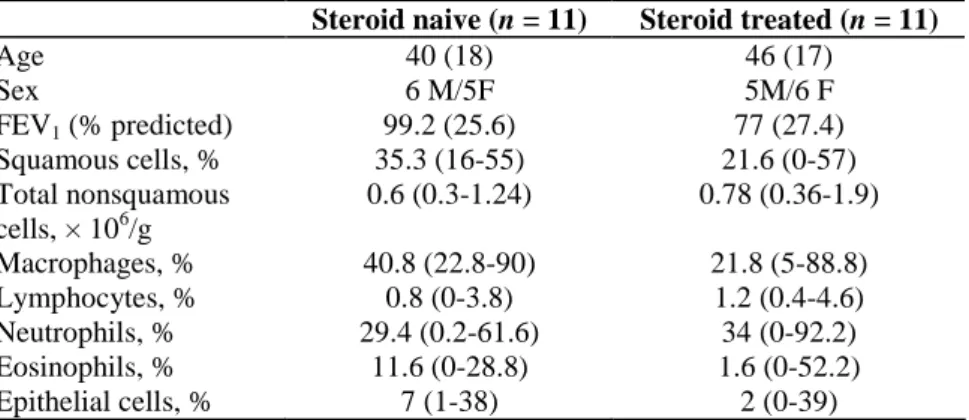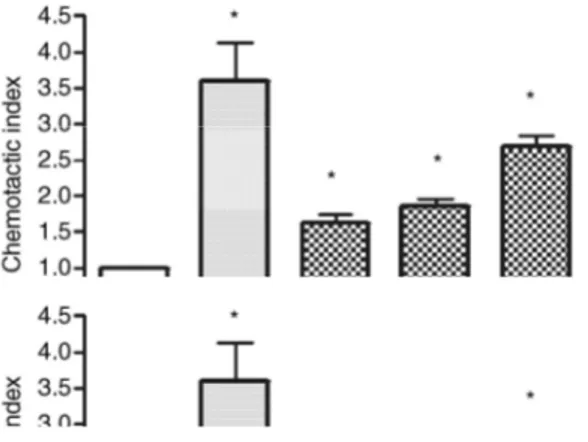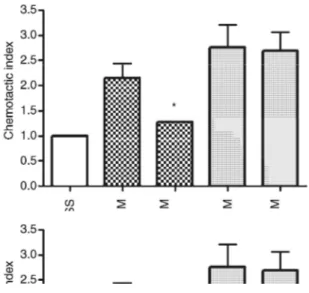Cysteinyl-leukotrienes contribute to sputum eosinophil chemotactic activity
in asthmatics
L. Hemelaers1, M. Henket1, J. Sele1, F. Bureau2, R. Louis1 1
Department of Pneumology, CHU Sart-Tilman, University of Liège; 2Centre for Cellular and Molecular Therapy (CTCM), University of Liège, Liège, Belgium
ABSTRACT
Background: Cysteinyl-leukotrienes are lipid derived mediators involved in asthma. They are able to stimulate eosinophil chemotaxis in vitro. Induced sputum from asthmatics has been shown to contain eosinophil
chemotactic activity. The purpose of our study was to evaluate the contribution of cysteinyl-leukotrienes to sputum eosinophil chemotactic activity in asthmatics and to seek whether there might be differences between asthmatics free of inhaled corticosteroids vs those regularly receiving this treatment. Methods: Twenty-two patients (11 corticosteroid free, mean FEV1 99% predicted, 11 corticosteroid-treated, mean FEV1 77% predicted) recruited from our asthma clinic underwent a sputum induction. Sputum was processed according to standard procedure. Eosinophil chemotactic activity contained in the fluid phase was assessed using Boyden
microchamber model and expressed as chemotaxis index (CI). Cysteinyl-leukotrienes were measured in sputum supernatant by ELISA and their role in sputum eosionophil chemotactic activity was evaluated by using montelukast, a selective antagonist of a cys-LT1 receptor. Results: Cysteinyl-leukotrienes were well detectable in sputum supernatants from both steroid-naive (247 ± 42 pg/ml) and steroid-treated (228 ± 26 pg/ml)
asthmatics. Sputum eosinophil chemotactic activity was indiscriminately present in both corticosteroid-naive (CI: 2.61 ± 0.22) and corticosteroid-treated (2.98 ± 0.35) asthmatics. Montelukast (100 µM) significantly inhibited the eosinophil chemotactic activity in both groups achieving a mean inhibition of 54.2 ± 9.2% (P < 0.001) and 64.7 ± 7.8% (P < 0.001) in steroid-naive and steroid-treated asthmatics respectively. Conclusion: Cysteinyl-leukotrienes actively participate in sputum eosinophil chemotactic activity found in asthmatics irrespective of whether they are or not under treatment with inhaled corticoids.
Keywords : asthma ; cysteinyl-leukotrienes ; sputum eosinophil chemotactic activity.
Airways eosinophilia is a prominent feature of classic asthma as well as cough variant asthma (1, 2). Although sputum eosinophil count only plays a limited role in determining airways hyperresponsiveness to methacholine (3) and acute and late airways obstruction following an allergen inhalation in asthmatics (4), it still might be relevant to the mechanisms leading to a loss of disease control (5, 6) or to an asthma exacerbation (7). This might be linked to the fact that high sputum eosinophil count seems to be associated with a lack of plateau during a metacholine bronchial provocation (2).
Induced sputum is a useful tool to monitor airway allergic inflammation (8). We have previously shown that induced sputum from asthmatics contained eosinophil chemotactic activity not found in healthy subjects (9). Cysteinyl-leukotrienes are mediators endowed with chemotactic activity towards eosinophils in vitro (9, 10). Inhalation of cysteinyl leukotrienes results in a rise in sputum eosinophil counts within a few hours (11). Cysteinyl-leukotrienes levels were found to be raised in sputum from asthmatics and correlated with asthma severity (12).
The purpose of our work was to investigate the contribution of cysteinyl-leukotrienes to sputum eosinophil chemotactic activity in asthmatics. Therefore we measured the levels of cysteinyl-leukotrienes as well as the eosinophil chemotactic activity in sputum supernatants and assessed the impact of montelukast, a cysteinyl-leukotrienes receptor antagonist, on sputum chemotactic activity from both corticosteroid-naive and corticosteroid-treated asthmatics.
Material and methods
Subjects
Twenty-two subjects were recruited from our asthma clinic to undergo a sputum induction. Asthma was defined as a clinical history of recurrent wheeze, breathlessness or cough associated with either bronchial
hyperresponsiveness to methacholine (PC20 M ≤ 16 mg/ml) or FEV1 reversibility > 12% to inhaled 400 µg salbutamol. Eleven of them were regularly treated with inhaled corticoids with an average dosage of 1560 µg equivalent BDP per day (range from 400 µg to 2000 µg) and seven of them received a combination of inhaled corticoids and long acting β2 agonists. None of them were receiving theophylline. Their demographic, functional and sputum characteristics are given in Table 1. The protocol of the study was approved by our local ethical committee and each subject gave written informed consent.
Table 1: Demographic and functional characteristics and sputum cell counts in steroid-naive and steroid-treated
asthmatics
Steroid naive (n = 11) Steroid treated (n = 11)
Age 40 (18) 46 (17) Sex 6 M/5F 5M/6 F FEV1 (% predicted) 99.2 (25.6) 77 (27.4) Squamous cells, % 35.3 (16-55) 21.6 (0-57) Total nonsquamous 0.6 (0.3-1.24) 0.78 (0.36-1.9) cells, × 106/g Macrophages, % 40.8 (22.8-90) 21.8 (5-88.8) Lymphocytes, % 0.8 (0-3.8) 1.2 (0.4-4.6) Neutrophils, % 29.4 (0.2-61.6) 34 (0-92.2) Eosinophils, % 11.6 (0-28.8) 1.6 (0-52.2) Epithelial cells, % 7 (1-38) 2 (0-39)
Age and FEV1 values are expressed as mean (SD). Sputum cell counts results are expressed as median (range).
Sputum induction and processing
Hypertonic saline solution (NaCl 4.5%) was aerosolized by an ultrasonic nebulizer (Ultra Neb 2000; De Vilbiss, Feltham, Middlesex, UK) with output set at 1.5 ml/min. The subjects wearing a nose clip inhaled aerosol through a mouthpiece during 10-15 min. Sputum was collected and the whole sputum processed as previously described in order to perform total and differential counts and to assess biological activity of the fluid phase of the samples (3).
Eosinophil isolation and chemotaxis
Granulocytes were isolated from heparin-anticoagulated peripheral blood of a mild asthmatic volunteer not taking inhaled corticoids. Eosinophils were purified (99%) by immunomagnetic cell separation (MACS; Miltenyi Biotec, Bergisch Gladbach, Germany), using anti-CD16 as described by Hatzelman et al. (13). Chemotaxis assays for eosinophils were performed using micro-Boyden chambers (Neuroprobe, Gaithersburg, MD). Experiments were performed in triplicate in a 48-well microchemotaxis Boyden chamber incubated in 5% CO2 at 37°C for 60 min. Aliquots of 25 µl of chemotactic agents like Platelet-activating factor 0.1 µM (PAF, Sigma, St Louis, MO), cysteinyl-leukotriene D4 (LTD4; Caiman, Ann Arbor, MI) or sputum supernatants were placed in the lower wells and 50 µl of eosinophil suspension (106 cells/ml) were placed in the upper wells. The two chambers were separated by a polyvinyl pyrrolidone free filter (Nucleopore, Whatman, Middlesex, UK). The controls consisted of a solution of Hank's balanced salt solution (HBSS) with Ca2+ (pH 7.4). The filters were fixed in methanol and stained with Diff-Quick. Migrated cells adherent to the lower surface were counted in 10 fields/well under a light microscope with a magnification x600. In experiments investigating the effect of montelukast (10 nM to 100 µM; Merck, Sharpe and Dohne, Rahway, NJ) the drug was added to sputum supernatants, LTD4 or PAF and let for 90 min for incubation prior to chemotaxis assay. Montelukast was also added at the same concentration to the eosinophil suspension in the upper chamber. The results were expressed as the chemotactic index (CI) that is the number of cells having migrated in the presence of the chemotactic agent or the sputum divided by the number of cells having migrated in the presence of HBSS alone.
Cysteinyl-leukotrienes immunoassay
Cysteinyl-leukotrienes were measured by enzyme immunoassay employing a cysteinyl-leukotriene polyclonal antiserum (Cayman Chemical, Ann Arbor, MI) after prior purification on C18 columns (Varian, INC, Canada). The recovery rate was 80% and samples were corrected accordingly. The sensitivity of the ELISA was 7 pg/ml.
Statistical analyses
According to the normality of the distribution based on Kolmogorov-Smirnov results for chemotaxis
experiments were expressed as mean ± SEM while those of sputum cysteinyl-leukotrienes levels were expressed as median (range). Assessment of the CI of pharmacological agents or sputum supernatants was performed by using a one sample 't' test with an hypothetical value of 1 representing the CI of HBSS. Assessment of the inhibitory effect of montelukast on chemotaxis was performed by using a paired Student 't' test. P-values <0.05 were considered as statistically significant.
Results
Effect of LTD4 on eosinophil chemotaxis in Boyden microchambers model
LTD4 caused a dose-related eosinophil chemotactic activity in the range of 0.001-10 nM with a significant effect (P < 0.05) at 0.001 nM (Fig. 1). The chemotactic activity generated by LTD4 (0.7 nM) was strongly inhibited by montelukast 100 µM, a specific cyst-LTl receptor antagonist (89 ± 1%). By contrast montelukast was completely unable to inhibit the chemotactic activity generated with PAF 100 nM (Fig. 2)
Cysteinyl-leukotrienes as factors contributing to sputum eosinophil chemotactic activity
Sputum cysteinyl-leukotrienes levels were 215 pg/ml (94-565) and 161 pg/ml (119-434) and not significantly different in steroid-naive (n = 11) and steroid-treated asthmatics (n= 11) respectively (P = 0.72). This range of concentrations approximately corresponds to 0.2-1 nM, that is a concentration range endowed with significant chemotactic activity for human eosinophils in vitro as described in Fig. 1.
Significant sputum eosinophil chemotactic activity was present in both steroid-naive (CI: 2.61 ± 0.22; P < 0.0001) and steroid-treated asthmatics (CI: 2.98 ± 0.35; P < 0.0001) and not significantly different between the groups (P = 0.47). There was no significant relationship between sputum eosinophil chemotactic and eosinophil counts in any of the two groups (r = -0.22; P = 0.36 in corticosteroid-naive and r = 0.20; P = 0.41 in
corticosteroid-treated patients respectively). Montelukast 100 µM caused a mean inhibition of sputum eosinophil chemotactic activity reaching 54.2 ± 9.2% (P < 0.0001) and 64.7 ± 7.8% (P < 0.001) in steroid-naive and steroid-treated asthmatics respectively (Fig. 3). The extent of inhibition afforded by montelukast was not significantly different between the two groups of asthmatics.
Figure 1: Eosinophil chemotaxis induced by LTD4 (0.001-10 nM) and PAF (100 nM) in the Boyden
microchamber model. Results are expressed as mean ± SEM (n = 4). *Chemotactic index significantly different (P < 0.05) from 1 which is the value obtained with HBSS alone.
Figure 2: Specific inhibitory effect of Montelukast (100 µM) on eosinophil chemotaxis induced by LTD4 (10-10
M) and PAF (10-7 M). Results are expressed as mean ± SEM (n = 3). The SEM (0.02) is so small for the bar LTD4 + MT that it does not appear graphically.
Figure 3: Inhibition by montelukast of sputum eosinophil chemotactic activity (SI) in steroid-naive
(hatched bars, n = 11) and steroid-treated asthmatics (squared bars, n = 11). MT = montelukast 100 µM. Results are expressed as mean ± SEM. *P < 0.05 compared with SI without montelukast.
Discussion
Sputum supernatants from asthmatics contain measurable amounts of cysteinyl-leukotrienes which did not differ between those receiving or not receiving regular treatment with inhaled corticosteroids. Our study shows, for the first time, that cysteinyl-leukotrienes may contribute to the eosinophil chemotactic activity found in the sputum from both corticosteroid-naive and corticosteroid-treated asthmatics.
We found that sputum supernatant from asthmatics contains detectable amounts of cysteinyl-leukotrienes, which is in keeping with previous studies performed in asthmatics (12, 14). The range of cysteinyl-leukotriene
concentrations we found here is somewhat lower than that reported by Pavord and coworkers (12, 14). There is however a potential explanation for this observation as the latter authors used the plug of the sputum sample whereas we used the whole sample. As the plug method is recognized to concentrate the biochemical compounds in the fluid phase (14, 15), it appears logical to find lower concentrations in the supernatant coming from the whole samples. Interestingly the concentrations of cysteinyl-leukotrienes measured in our supernatants were shown to exhibit clear eosinophil chemotactic activity in vitro. This is an important observation which made
cysteinyl-leukotrienes potential contributors to chemotactic activity exhibited by sputum supernatants. The confirmation for this hypothesis came from the demonstration that montelukast, a cystLT1 receptor antagonist, was able to decrease the sputum eosinophil chemotactic activity by 50-60%. The residual chemotactic activity of sputum samples is likely to be dependent on the presence in the fluid phase of other chemotactic agents than cysteinyl-leukotrienes. It is worth noting that montelukast possessed similar inhibitory effect on samples from asthmatics irrespective of whether they were or not currently treated with inhaled corticosteroids. This goes in line with the documented inability of corticosteroids to adequately control the release of cysteinyl-leukotrienes in the airways of asthmatics (16). The extent of inhibition obtained in our study is slightly lower than that achieved with a specific monoclonal antibody directed towards eotaxin which was shown to range from 52% to 86% inhibition in moderate to severe asthma (17). Our finding complements the data from Dent et al. and show that, besides eotaxin, cysteinyl-leukotrienes also contribute to the eosinophil chemotactic activity. Interestingly we found here that cysteinyl-leukotrienes were involved in mild asthma which was not the case for eotaxin, the contribution of which mainly prevailed in moderate to severe asthma (17).
In agreement with Dent et al. (17) we did not find relationship between sputum eosinophil counts and the chemotactic activity towards this cell type. This highlights the complexity of the mechanisms involved in the regulation of the number of eosinophils present in the airways. In this regard it has recently been suggested that priming of circulating eosinophils is a critical step prior to cell extravasation and tissular recruitment (18). Although the group receiving inhaled corticosteroids and still displaying reduced FEV1 values has to be considered as more severe than the corticosteroid-naive group displaying normal FEV1, the extent of sputum chemotactic activity was rather similar between the groups. This argues against a clear link between the magnitude of sputum chemotactic activity and asthma severity which is in keeping with Dent's study (17). The question as to whether inhibition of sputum eosinophil chemotaxis has impact that may translate into clinical benefit is not resolved by our study.
In conclusion, cysteinyl-leukotrienes significantly contribute to the eosinophil chemotactic activity contained in sputum from asthmatics. The proportion of this contribution is similar between mild and moderate to severe asthmatics and not affected by regular treatment with inhaled corticosteroids.
References
1. Bousquet J, Chanez P, Lacoste JY, Barneon G, Ghavanian N, Enander I et al. Eosinophilic inflammation in asthma. N Engl J Med 1990;323:1033-1039.
2. Yoo Y, Koh YY, Kang H, Yu J, Nah KM, Kim CK. Sputum eosinophil counts and eosinophil cationic protein levels in cough-variant asthma and in classic asthma, and their relationships to airway hypersensitivity or maximal airway response to methacholine. Allergy 2004;59:1055-1062.
3. Louis R, Sele J, Henket M, Cataldo D, Bettiol J, Seiden L et al. Sputum eosinophil count in a large population of patients with mild to moderate steroid-naive asthma: distribution and relationship with methacholine bronchial hyperresponsiveness. Allergy 2002;57:907-912. 4. Leckie MJ, ten Brinke A, Khan J, Diamant Z, O'Connor BJ, Walls CM et al. Effects of an interleukin-5 blocking monoclonal antibody on eosinophils, airway hyper-responsiveness, and the late asthmatic response. Lancet 2000;356:2144-2148.
5. Louis R, Lau LC, Bron AO, Roldaan AC, Radermecker M, Djukanovic R. The relationship between airways inflammation and asthma severity. Am J Respir Crit Care Med 2000;161:9-16.
6. Romagnoli M, Vachier I, Tarodo dlF, Meziane H, Chavis C, Bousquet J et al. Eosinophilic inflammation in sputum of poorly controlled asthmatics. Eur Respir J 2002;20:1370-1377.
7. Green RH, Brightling CE, McKenna S, Hargadon B, Parker D, Bradding P et al. Asthma exacerbations and sputum eosinophil counts: a randomised controlled trial. Lancet 2002;360:1715-1721.
8. Venge P. Monitoring the allergic inflammation. Allergy 2004;59:26-32.
9. Louis R, Shute J, Biagi S, Stanciu L, Marrelli F, Tenor H et al. Cell infiltration, ICAM-1 expression, and eosinophil chemotactic activity in asthmatic sputum. Am J Respir Crit Care Med 1997;155:466-472.
10. Spada CS, Nieves AL, Krauss AH, Woodward DF. Comparison of leuko-triene B4 and D4 effects on human eosinophil and neutrophil motility in vitro. J Leukoc Biol 1994;55:183-191.
11. Laitinen LA, Laitinen A, Haahtela T, Vilkka V, Spur BW, Lee TH. Leukotriene E4 and granulocytic infiltration into asthmatic airways. Lancet 1993;341:989-990.
12. Pavord ID, Ward R, Woltmann G, Wardlaw AJ, Sheller JR, Dworski R. Induced sputum eicosanoid concentrations in asthma. Am J Respir Crit Care Med 1999;160:1905-1909.
13. Hatzelmann A, Tenor H, Schudt C. Differential effects of non-selective and selective phosphodiesterase inhibitors on human eosinophil functions. Br J Pharmacol 1995;114:821-831.
14. Brightling CE, Ward R, Woltmann G, Bradding P, Sheller JR, Dworski R et al. Induced sputum inflammatory mediator concentrations in eosinophilic bronchitis and asthma. Am J Respir Crit Care Med 2000;162:878-882.
15. Spanevello A, Beghe B, Bianchi A, Migliori GB, Ambrosetti M, Neri M et al. Comparison of two methods of processing induced sputum: selected versus entire sputum. Am J Respir Crit Care Med 1998;157:665-668.
16. Dworski R, Fitzgerald GA, Oates JA, Sheller JR. Effect of oral prednisone on airway inflammatory mediators in atopic asthma. Am J Respir Crit Care Med 1994;149:953-959.
17. Dent G, Hadjicharalambous C, Yoshikawa T, Handy RL, Powell J, Anderson IK et al. Contribution of eotaxin-1 to eosinophil chemotactic activity of moderate and severe asthmatic sputum. Am J Respir Crit Care Med 2004;169:1110-1117.
18. Luijk B, Lindemans CA, Kanters D, van der Heijde R, Bertics P, Lammers JW et al. Gradual increase in priming of human eosinophils during extravasation from peripheral blood to the airways in response to allergen challenge. J Allergy Clin Immunol 2005;115:997-1003.


